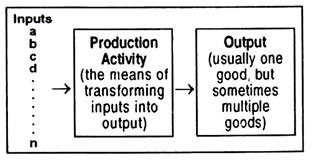Let us study about the theory of production function. After reading this article you will learn about: 1. Concept of the Theory of Production Function 2. Importance of the Theory of Production Function.
Concept of the Theory of Production Function:
The theory of production and cost (Cost function is derived from the production function) is central to the economic management of the firm. The starting point of the theory of production is the technology of production of the firm. This technology describes the relationship between inputs and output.
This relationship or the production function governs the level of production. Output is a function of inputs. In the short run, output behaviour is governed by the levels of non- proportional returns. Here we keep some inputs fixed. In the long run, inputs are subject to change.
Importance of the Theory of Production Function:
The theory of production is at the heart of business economics. That is why, its importance is great. Firstly, cost theory is a derived theory—it is derived from the production theory. Cost has great relevance in the determination of price of a commodity.
ADVERTISEMENTS:
Secondly, the theory of production may be used in the determination of rewards of an input. The basis of input demand theory is indeed the theory of production.
The Production Function:
The key concept in the theory of production is the production function. The word ‘function’ in mathematics expresses the relationship between dependent and independent variables. Or a function shows a cause—and—effect relationship. The production function shows the technological or engineering relationship between inputs (independent variables or cause) and output (dependent variable or effect).
A general production function can be written as:
ADVERTISEMENTS:
Output = f (input1, input2, input3 …. inputn)
Using one-output and two-input function, the relationship between output and inputs is summarized in the following form:
Q = f (L, K)
where Q denotes the quantity of output produced and L and K denote the respective quantities of labour—the human resource— and capital—the physical resource—used. By using L and K in a production process, one obtains output (Q). The technician or the engineer of an establishment describes the production process in terms of variables such as pressure, density and horse power.
ADVERTISEMENTS:
The economist’s production function incorporates the engineering technology. Production engineers tell us how many units of L and K are used to yield a given output by using a particular process of production. Which particular production process (out of various alternatives) will be chosen by the firm depends on the prices of inputs and output that are bought and sold in the market place.
Thus, a production function, being a technical one, presents physical combinations only. It does not say anything about least-cost input combination or maximum profitable output. In brief, a production function is a graph or a table or an equation showing the maximum output that can be produced with the help of inputs.
To the economists, a production function is something more. A production function shows costs for using inputs and revenues for output sold. As the production function is given in the form of a table showing physical combinations of different inputs to obtain certain unit of output, it is not within the domain of economics.
Economists are concerned not with the physical combinations but with the costs, revenue, output behaviour in response to changes in inputs used, etc. Whenever there is a change in input usage in a production process, the output changes. Why does output change in this way or that way is studied by economists through production function. Consequently, different laws governing output are obtained.
The form of production function of an establishment is determined by the state of technology whose size depends on the time span. This means that a short run production function is different from a long period production function. To understand the difference, let us define short run and long run.
